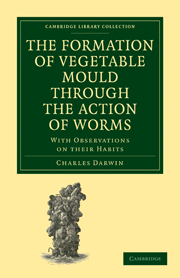Book contents
- Frontmatter
- Contents
- INTRODUCTION
- CHAPTER I HABITS OF WORMS
- CHAPTER II HABITS OF WORMS—continued
- CHAPTER III THE AMOUNT OF FINE EARTH BROUGHT UP BY WORMS TO THE SURFACE
- CHAPTER IV THE PART WHICH WORMS HAVE PLAYED IN THE BURIAL OF ANCIENT BUILDINGS
- CHAPTER V THE ACTION OF WORMS IN THE DENUDATION OF THE LAND
- CHAPTER VI THE DENUDATION OF THE LAND—continued
- CHAPTER VII CONCLUSION
- INDEX
CHAPTER II - HABITS OF WORMS—continued
Published online by Cambridge University Press: 29 August 2010
- Frontmatter
- Contents
- INTRODUCTION
- CHAPTER I HABITS OF WORMS
- CHAPTER II HABITS OF WORMS—continued
- CHAPTER III THE AMOUNT OF FINE EARTH BROUGHT UP BY WORMS TO THE SURFACE
- CHAPTER IV THE PART WHICH WORMS HAVE PLAYED IN THE BURIAL OF ANCIENT BUILDINGS
- CHAPTER V THE ACTION OF WORMS IN THE DENUDATION OF THE LAND
- CHAPTER VI THE DENUDATION OF THE LAND—continued
- CHAPTER VII CONCLUSION
- INDEX
Summary
In the pots in which worms were kept, leaves were pinned down to the soil, and at night the manner in which they were seized could be observed. The worms always endeavoured to drag the leaves towards their burrows; and they tore or sucked off small fragments, whenever the leaves were sufficiently tender. They generally seized the thin edge of a leaf with their mouths, between the projecting upper and lower lip; the thick and strong pharynx being at the same time, as Perrier remarks, pushed forward within their bodies, so as to afford a point of resistance for the upper lip. In the case of broad flat objects they acted in a wholly different manner. The pointed anterior extremity of the body, after being brought into contact with an object of this kind, was drawn within the adjoining rings, so that it appeared truncated and became as thick as the rest of the body. This part could then be seen to swell a little; and this, I believe, is due to the pharynx being pushed a little forwards. Then by a slight withdrawal of the pharynx or by its expansion, a vacuum was produced beneath the truncated slimy end of the body whilst in contact with the object; and by this means the two adhered firmly together. That under these circumstances a vacuum was produced was plainly seen on one occasion, when a large worm lying beneath a flaccid cabbage leaf tried to drag it away; for the surface of the leaf directly over the end of the worm's body became deeply pitted.
- Type
- Chapter
- Information
- The Formation of Vegetable Mould through the Action of WormsWith Observations on their Habits, pp. 55 - 128Publisher: Cambridge University PressPrint publication year: 2009First published in: 1881



